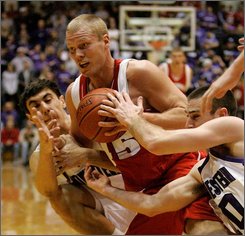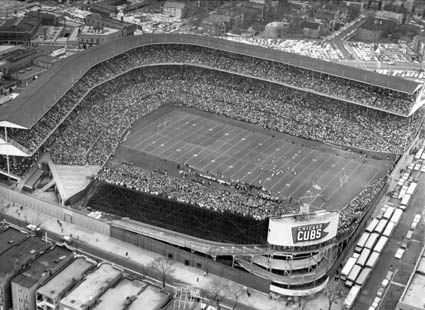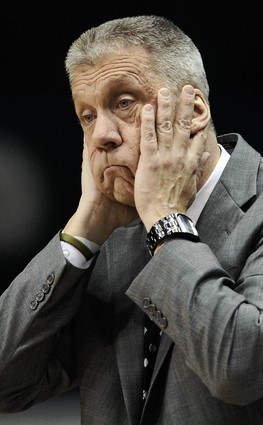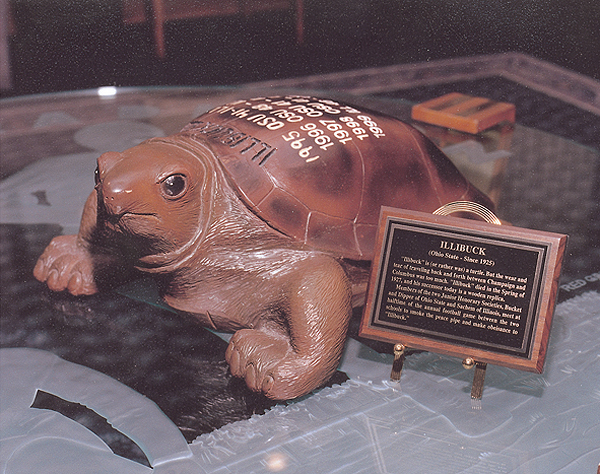
Ah, I love the smell of napalm and crushed Big Ten expansion dreams in the morning. Judging by the over 1000 comments to last week’s post (a record number for the blog), we’re all exasperated that Jim Delany and the Big Ten have at least publicly stated that they will stick to original timetable of 12-18 months to examine expansion candidates. This is certainly a fascinating topic, but Lord help me if I’m still speculating12 months from now about who the Big Ten will be adding. At that point, I’d rather be speculating about… Big East expansion! Let’s get to my thoughts on last week’s events:
(1) You lie!!! – In all seriousness, I’m not one of those people that subscribe to conspiracy theories and break every conference official comment down like the Zapruder film. However, if there’s one thing that needs to be beaten into people’s heads after this past week, it’s this: TRUST NO ONE. The various of lists of 5 and 15 candidates that the Big Ten leaked and every public comment that has been uttered mean nothing to me at this point. The one reporter that seemed to actually have a decent clue as to what was going on in the Big Ten expansion story, Teddy Greenstein of the Chicago Tribune, appeared to get solid information that the conference was fast-tracking adding new schools and then had to make a complete retraction a couple days later. If Greenstein is getting played by the Big Ten, then every other reporter is getting played, as well. I’ve received info from credible people that Texas and Notre Dame are definitely still in legitimate play for the Big Ten and other info that the conference has moved on regarding both of them. Commenters have posted information suggesting that Maryland preemptively nixed any consideration for Big Ten membership and that Northwestern’s president revealed to a sorority that the conference had actually made a decision as to who it was inviting. Tom Shatel, one of the Nebraska beat writers at the Omaha World-Herald, shared his frustration that people he trusted last week that stated that the Cornhuskers weren’t part of the Big Ten expansion talks are now saying that the school is definitely in the mix. It’s impossible to parse through what’s true or false in all of this.
At this point, there is no combination of Notre Dame and/or any Big East and/or Big 12 schools that are AAU members that would surprise me. If the Big Ten announces in June 2011 that it’s adding Pitt, Syracuse and Rutgers, I wouldn’t flinch. If the Big Ten announces in 2 weeks that it’s adding Texas, Texas A&M and Notre Dame, it wouldn’t faze me at all. It’s all fair game at this point. The leaks so far have been so contradictory that we’re all better off assuming that they’re red herrings. There’s a plan out there that might be way more aggressive than even the Super Death Star Conference that I’ve brought up or it could very well be a conservative addition of a geographically contiguous school or 3 purely for households. No one except for Jim Delany and the Big Ten university presidents knows WTF is going on.
Of course, we’ll still have fun pouncing on every leak and rumor in the meantime.
(2) Backdoor meetings are where it’s at – Some commenters astutely noted that Jim Delany isn’t going to call a press conference one day and say, “I’ve just informed the Big East and Big XII that they need to bend over and assume the position.” If and when Delany talks to his fellow commissioners, it’s going to be private and it’s likely such commissioners would want to keep it that way so they can start planning for their own raids of leagues like the Mountain West and Conference USA. Delany would certainly not want anything to do with speaking about anything substantive with the feeding frenzy of the media horde gathered at the BCS meetings last week. This seems like such a simple and logical concept, yet in a world where we’re craving information on this subject, we’re dying for any type of official statement of a go-ahead.
(3) Time is on the Big Ten’s side – I really doubt the Big Ten is going to take the full 12-18 months to examine this expansion issue. That’s just my gut feeling as the university presidents likely wouldn’t be able to stomach having this story hanging over their heads in the press for such a long period of time. It could very well be the case that the Big Ten’s university presidents know how they want to proceed and that they simply didn’t want Delany to inform the Big 12 and/or Big East commissioners of the Big Ten’s targets at the media-filled BCS meetings. Honestly, I don’t know what could be taking so long unless the Big Ten is vetting every single possibility with the two schools that matter the most: Notre Dame and Texas. Those are certainly two schools worth waiting for if the Big Ten believes that either of them would be willing to join. Every single other school in the Big East and Big XII would leap toward Big Ten membership, so if the Big Ten was solely targeting non-Notre Dame/Texas schools, this could’ve been wrapped up weeks ago.
(4) Big East being “proactive” by “hiring” Paul Tagliabue and expanding to Jacksonville – As Brian Cook of Sporting News and mgoblog (not the former Illini quasi-great) stated, “Soviet Big East Raids You!” (I’m not going to lie – I could keep myself entertained making up Yakov Smirnoff-isms for hours at a time.) On paper, it sounds like a massive coup that former NFL commissioner Paul Tagliabue has been tapped as a strategist for the Big East. He’s actually providing his services pro bono because he has a very direct interest in how all of this plays out as Chairman of the Board of the Directors at Georgetown. What does this mean? Well, if Tagliabue has anything to do with it, the hybrid format of the conference will continue on into perpetuity. Georgetown would be severely damaged if the Big East split up and one of his tasks will be to ensure that doesn’t happen. If the Big East were to lose multiple schools, he has the gravitas to tell schools that might be ready to split (i.e. Louisville) that the hybrid is still the revenue maximization model for the conference. The Big East football schools might not trust anything that the Big East office says anymore, but if the former commissioner of the NFL says that ESPN will still pay a lot more money for a hybrid league than a split league, then that’s going to carry a lot of weight. As a DePaul law grad, though, I really hope that Tagliabue doesn’t decide that the Big East would be better off skipping the Los Angeles market in favor of the next municipality that whores itself with a taxpayer-financed stadium.
Honestly, there is absolutely nothing “proactive” that the Big East can do at this point to prevent a member from leaving for the Big Ten. Even if the Big East could somehow create a new TV network that could generate large amounts of cash, there’s no way that could be up and running even if the Big Ten takes the maximum amount of time to complete its expansion process.
Of course, Tagliabue unintentionally torpedoed the prospect of the Big East ever creating its own network by dumping on the thought that the Big Ten adding schools in the New York area would deliver homes for the Big Ten Network by saying the following:
“One of the real challenges for the networks is to provide value, but you only provide value in markets where you provide traction,” he said. “Is Minnesota and Rutgers going to get a big rating on Long Island? Give me a break. Every game isn’t Michigan and Michigan State.” He added, “Am I going to rush home from a tennis game on Saturday to watch Minnesota and Rutgers if I live on Long Island?”
Now, I’m not exactly a favorite person with the Rutgers message board crowd, but I’ve got to defend the school here. WTF was Tagliabue doing completely ripping apart a current member of the Big East when his job is to presumably keep the conference intact? Maybe he was suggesting that Midwestern schools like Minnesota wouldn’t exactly attract the Long Island tennis club crowd, which is likely true, yet that’s quite a disingenuous statement coming from someone representing a league that includes Louisville, South Florida and Cincinnati (who don’t conjure up images of summer parties in the Hamptons). In fact, the highly-rated 2006 Rutgers game where the Empire State Building was lit up in scarlet red was against Louisville as opposed to an Eastern school, which goes to show you that New Yorkers simply want to watch good teams play other good teams regardless of geographic location. If I were a Rutgers fan, I don’t know how I could deal with someone in a leadership position in the Big East saying that about my school. At worst, it was a complete cheap shot and at best, it came off extremely wrong with logic that didn’t follow considering that the Big East isn’t a purely Northeastern football league anymore.
(5) ESS – EEE – SEE SPEEEED! – SEC Commissioner Mike Slive articulated the real reason for expansion: it’s a high stakes pissing contest to see who can lay claim to the “Bad Motherfucker” wallet. More than anyone, there’s kind of this lingering assumption that if the Big Ten expands to 16 schools, then the SEC MUST respond because it simply can’t handle not being the biggest (and therefore, the best).
Frankly, this line of thinking doesn’t make sense to me at all. I know a lot of fairly knowledgeable people are convinced that we’re going to end up with 4 16-team superconferences after everything shakes out, yet too many people seem to forget that every single conference other than the Big Ten doesn’t have a financial vehicle like the Big Ten Network that would make it financially viable to perform such a large-scale expansion. The Big Ten isn’t expanding just to expand – it’s looking to maximize the per-school payout for each of its members. All of the other conferences are going to do the same and I fail to see how any of them would be able to make it a profitable venture to expand beyond 12 without its own conference network. Heck, even the Big Ten isn’t guaranteed a windfall by going beyond 12 schools (even though it at least has an argument with the Big Ten Network).
In the case of the SEC, there are very few schools that make sense for it in terms of expansion at all. I see names thrown around like Miami, Florida State, Georgia Tech and Clemson, but all of them would be duplicate teams in markets that the SEC already owns. There’s very little point in the SEC adding more schools within its current footprint. In fact, there are only two markets that would add value to the SEC: Texas and North Carolina. The problem is that in order to obtain those markets, it would need to try to add the University of Texas and UNC, both of whom would likely completely shun the SEC due to academic reasons. Throughout this process, I’ve corresponded with many Texas alums (NOT the T-shirt fans that just care about football) and they’re pretty much unanimous in stating that the UT administration will NEVER entertain any thought of joining the SEC. It cannot be underestimated how much the academically-minded administrators at Texas loathe the thought of the SEC. I think about this every time I see a columnist wrongly assume that “Texas = South” and therefore “Texas = SEC”, when in reality UT likens itself to be more like Berkeley or Michigan as opposed to any of the SEC schools. UNC is even more snobby with respect to academics and the Tar Heels have emotional ties to the ACC that go far beyond what Texas has with the Big XII. So, the chances of the SEC adding either of those schools is between slim and none. Without them, there aren’t any other worthy markets in the South that the SEC hasn’t already covered.
(6) Why is this topic addictive? – A number of commenters have been wondering about why this expansion topic is so fascinating. As someone that had been writing this blog for 5 years about a variety of subjects and didn’t focus on conference realignment until the last few months, I’ve also been thinking about how I got hooked on it. At least for me, I’ve always enjoyed writing about big-picture movements in the sports world and you really can’t get much more big-picture than power schools switching conferences. Could you imagine if the Yankees and Red Sox approached the Cubs and Dodgers to join the AL East in order to form a super-division of all of baseball’s most popular teams? (Please note that as a die-hard White Sox fan, it pains me to admit how popular the Cubs are and will likely always be. I take solace in the fact that they’re paying $19 million to an 8th-inning setup guy.) Well, the equivalent isn’t just possible in college sports, but it’s happened numerous times. Within the past 20 years, Penn State joined the Big Ten, Miami joined the Big East and then later switched to the ACC and Texas helped form the Big XII and could be on the move again.
Let’s face it, though: this is like crack-cocaine to the sports blogging world. As regular commenter allthatyoucanleavebehind noted, it’s a lot more fun to talk about expanding with schools like Syracuse and Rutgers (or really anyone other than the massive players like Texas, Notre Dame and Nebraska) than to actually have to play them when expansion finally occurs. Once the Big Ten actually makes an announcement regarding expansion, we won’t have a quick fix of speculative blogging material anymore… at least until we start talking about Big XII expansion.
At that point, all I’ll want to do is to rush home from my tennis match to catch the Illinois vs. Rutgers game.
(Follow Frank the Tank’s Slant on Twitter @frankthetank111)
(Image from Retecool)





